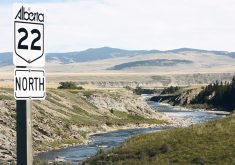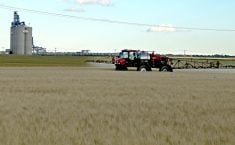A lot of soil health tests are on the market, but experts say digging down to check soil aggregates may work just as well
Sometimes, a shovel is better than a fancy tool.
As more farmers want to measure their soil health, companies and non-profit groups have devised a range of methods to test it.
Some of the tests work, but farmers could learn just as much by digging a hole in a field, said Marla Riekman, Manitoba Agriculture land management specialist.
“I love shovels. A shovel is going to tell you a lot,” said Riekman, who spoke about soil health tests at the Summit on Canadian Soil Health, held in early October at Oak Hammock Marsh, north of Winnipeg.
Read Also

New coal mine proposal met with old concerns
A smaller version of the previously rejected Grassy Mountain coal mine project in Crowsnest Pass is back on the table, and the Livingstone Landowners Group continues to voice concerns about the environmental risks.
“Sometimes, we can get a little too complex when we start talking about soil health diagnosis.”
There is no shortage of soil health tests on the market. Some test for the amount of biological activity in the soil, others for organic carbon and some have complicated names like Soil Labile Amino Nitrogen (SLAN).
Most of the soil health tests produce a number. Often, farmers will call Riekman and ask what the number means, but it’s difficult to answer that question.
“Hey, I got this soil test (result). Now what do I do with this?” Riekman said, recalling the phone calls. “That’s where I’m at a loss…. I don’t how to make a recommendation from (the results) of some of these tests.”
Andrew McGuire, a soil health expert at Washington State University, is also skeptical of tests.
“Those soil health indicators may or may not correlate with the actual problems you have with your soil …if you have a problem,” he wrote in a blog this summer.
The tests can and do work, but soil types vary greatly with geography and the climatic conditions. One July in Nipawin, Sask., could be incredibly dry and then extremely wet the next July.
“We need to understand those results can sometimes be affected by the seasonality or might not be repeatable,” Riekman said.
She isn’t telling farmers to avoid soil health tests. However, there are other ways to evaluate soil health.
Abbey Wick, a soil scientist at North Dakota State University, has said that farmers should examine soil aggregates to evaluate soil health. An aggregate is a group of soil particles that bind together, with organic matter, to form a lump or packet of soil.
“Organic matter serves as the nucleus for aggregate formation,” Wick said in a 2018 webinar.
Soil aggregates provide a number of benefits, such as creating habitats for soil microbes and creating pore space within the soil.
“Soil aggregates and soil aggregate stability … is one (thing) I really like people to look at,” Riekman said. “The aggregate formation is really that connection of the chemical and biological processes of that soil coming together.”
McGuire and Caley Gasch, a North Dakota State University soil scientist, have devised an even simpler way to evaluate soil health. They produced a list of questions, with yes or no answers:
- Does the soil blow or flow away?
- Does the soil allow water to soak in quickly?
- Does the soil drain?
- Does the soil crust?
- Does the crop recover most of the nutrients you apply?
- Are there areas where plants die or grow poorly?
The answers will help a grower identify problems with the soil and know if it is functioning, or not.
“What we want is for the soil to function in a way that enhances the main goal of agriculture: to produce food,” McGuire wrote. “And to keep on producing food.”


















